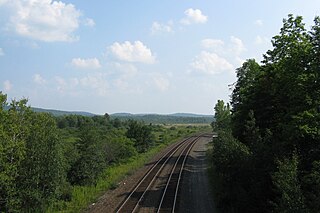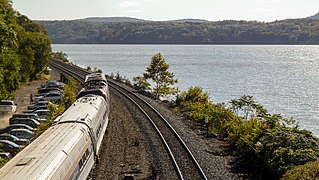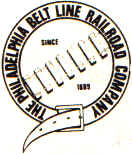Related Research Articles
The Junction Railroad was a railroad created in 1860 to connect lines west of downtown Philadelphia, Pennsylvania, and allow north-south traffic through the metropolitan area for the first time. The railroad consisted of 3.56 miles of double track and 5.3 miles of sidings. It owned no locomotives or rolling stock. The line connected the Philadelphia and Reading Rail Road line at the west end of the Columbia Bridge over the Schuylkill River, crossed the Pennsylvania Railroad line, ran parallel to Market Street, and turned south to connect with the Philadelphia, Wilmington and Baltimore Railroad at Gray's Ferry.

The Baltimore and Potomac Railroad (B&P) operated from Baltimore, Maryland, southwest to Washington, D.C., from 1872 to 1902. Owned and operated by the Pennsylvania Railroad, it was the second railroad company to connect the nation's capital to the Northeastern U.S., and competed with the older Baltimore and Ohio Railroad.

The Philadelphia, Wilmington and Baltimore Railroad (PW&B) was an American railroad that operated independently from 1836 to 1881. Headquartered in Philadelphia, it was greatly enlarged in 1838 by the merger of four state-chartered railroads in three Mid-Atlantic states to create a single line between Philadelphia and Baltimore.
The Baltimore and Philadelphia Railroad was a railroad line built by the Baltimore and Ohio Railroad (B&O) from Philadelphia, Pennsylvania, to the Maryland-Delaware state line, where it connected with the B&O's Philadelphia Branch to reach Baltimore, Maryland. It was built in the 1880s after the B&O lost access to its previous route to Philadelphia, the Philadelphia, Wilmington and Baltimore Railroad (PW&B). The cost of building the new route, especially the Howard Street Tunnel on the connecting Baltimore Belt Line, led to the B&O's first bankruptcy. Today, the line is used by CSX Transportation for freight trains.
The Frankfort Secondary Subdivision is a railroad line owned by CSX Transportation in the U.S. state of Indiana. The line runs from Clermont on the Crawfordsville Branch Subdivision north to Frankfort along a former Pennsylvania Railroad line.

The Harrisburg Subdivision is a railroad line owned by CSX Transportation in Pennsylvania. The line is located in Philadelphia, and connects Greenwich Yard and the Philadelphia Subdivision with the Trenton Subdivision along a former Pennsylvania Railroad line. Much of the Harrisburg Subdivision is the High Line' or West Philadelphia Elevated along 31st Street over the 30th Street Station area.

The Trenton Subdivision is a railroad line owned by CSX Transportation in the U.S. states of Pennsylvania and New Jersey. The line runs from CP NICE in Philadelphia, Pennsylvania, northeast to Port Reading Junction in Manville, New Jersey, along a former Reading Company line.
The Boston Subdivision is a railroad line in the U.S. state of Massachusetts. The line runs from Back Bay Station in Boston west to Wilbraham, just east of Springfield. along a former New York Central Railroad line. The line connects with the Northeast Corridor its east end and continues as the Berkshire Subdivision at its west end. Along the way, the line junctions with the Framingham Subdivision and Fitchburg Subdivision at Framingham.

The Berkshire Subdivision is a railroad line owned by CSX Transportation in the U.S. states of Massachusetts and New York. The line runs from near Springfield, Massachusetts west to Schodack, New York, along a former New York Central Railroad line. Its east end is in Wilbraham, east of Springfield, at the west end of the Boston Subdivision. Its west end is just east of the Alfred H. Smith Memorial Bridge, at a junction with the Castleton Subdivision and Schodack Subdivision. Along the way, the line junctions Amtrak's Post Road Branch in Schodack.
The Post Road Branch is a railroad line owned and operated by Amtrak in the U.S. state of New York. The line runs from a junction with CSX Transportation's Berkshire Subdivision in Castleton-on-Hudson, New York, northwest to CSX's Hudson Subdivision at Rensselaer, New York, along a former New York Central Railroad line. Freight service is provided by CSX Transportation, who calls it the Post Road Subdivision, via trackage rights.

The Amtrak Hudson Line, also known as the CSX Hudson Subdivision, is a railroad line owned by CSX Transportation and leased by Amtrak in the U.S. state of New York. The line runs from Poughkeepsie north along the east shore of the Hudson River to Rensselaer and northwest to Hoffmans via Albany and Schenectady along a former New York Central Railroad line. From its south end, CSX has trackage rights south to New York City along the Metro-North Railroad's Hudson Line. The Hudson Line junctions the Castleton Subdivision in Stuyvesant, Amtrak's Post Road Branch in Rensselaer and the Carman Subdivision in Schenectady. Its northwest end is at a merge with the Mohawk Subdivision. The entirety of the line overlaps with the Empire Corridor, one of Amtrak and the Federal Railroad Administration's candidate lines for future high-speed rail.
The Southern Tier Line is a railroad line owned and operated by the Norfolk Southern Railway in the U.S. states of New York and Pennsylvania. A mostly former Erie Railroad line, it is suggested that the line runs from Suffern, New York northwest to Buffalo, New York as it shares trackage with Metro-North Railroad’s Port Jervis Line from Suffern to Port Jervis; NS owns the Suffern to Port Jervis trackage and leases it to Metro-North so it can maintain it for its Port Jervis Line passenger operation. From its east end, NS has trackage rights south on the New Jersey Transit Main and Bergen County Lines to Conrail's North Jersey Shared Assets Area.
The Lincoln Secondary is a railroad line owned and operated by Conrail in the U.S. state of Michigan as part of its Conrail Shared Assets Operations.
The Sunbury Line, formerly known as Sunbury Subdivision, is a rail line owned and operated by Norfolk Southern Railway which in turn is owned by the Norfolk Southern Corporation. The line travels from Sunbury, Pennsylvania, to Binghamton, New York, connecting with Norfolk Southern's Southern Tier Line at Binghamton and Norfolk Southern's Buffalo Line at Sunbury.
The Conemaugh Line is a rail line owned and operated by the Norfolk Southern Railway in the U.S. state of Pennsylvania. The line runs from Conpit Junction, Pennsylvania northwest and southwest to Pittsburgh, following the Conemaugh, Kiskiminetas, and Allegheny rivers, on the former main line of the Conemaugh Branch of the Pennsylvania Railroad (PRR). At its east end, it merges with the Pittsburgh Line; its west end is where it merges with the Fort Wayne Line at the northwestern tip of Allegheny Commons Park. The line was used by the PRR as a low-grade alternate to its main line, which is now part of Norfolk Southern's Pittsburgh Line, in the Pittsburgh area.

The Schuylkill Branch was a rail line owned and operated by the former Pennsylvania Railroad (PRR) in Pennsylvania. The line ran from the Philadelphia to Harrisburg Main Line at 52nd Street in Philadelphia north via Norristown, Reading, and Pottsville to Delano Junction, about 2.5 mi (4.0 km) northeast of Delano. From Delano Junction, the PRR had trackage rights over the Lehigh Valley Railroad's Hazleton Branch and Tomhicken Branch to Tomhicken, where the PRR's Catawissa Branch began.

The Main Line of the Pennsylvania Railroad was a rail line in Pennsylvania connecting Philadelphia with Pittsburgh via Harrisburg. The rail line was split into two rail lines, and now all of its right-of-way is a cross-state corridor, composed of Amtrak's Philadelphia to Harrisburg Main Line and the Norfolk Southern Railway's Pittsburgh Line.
The Fort Wayne Line and Fort Wayne Secondary is a rail line owned and operated by the Norfolk Southern Railway (NS), Chicago, Fort Wayne and Eastern Railroad (CFE), and CSX Transportation in Pennsylvania, Ohio, and Indiana. The line runs from Pittsburgh, west via Fort Wayne, Indiana, to Gary, Indiana, along what was once the Pennsylvania Railroad's Pittsburgh to Chicago main line.

The Atlantic Avenue Railroad was a company in the U.S. state of New York, with a main line connecting downtown Brooklyn with Jamaica along Atlantic Avenue. It was largely a streetcar company that operated its own trains, but the Long Island Rail Road operated both streetcars and steam trains over its main line. It later became part of the Nassau Electric Railroad, but is now divided between the active Atlantic Branch of the LIRR and the unused Cobble Hill Tunnel, which is preserved in its original state, albeit without service tracks.

The Philadelphia Belt Line Railroad owns a 2.66-mile (4.28 km) long railroad line running along the Delaware River waterfront in Philadelphia, Pennsylvania. It was created in 1889 to allow any Philadelphia railroad to access the waterfront. The railroad, which does not operate any trains itself, is currently maintained by Conrail Shared Assets Operations and used by CSX Transportation and Norfolk Southern Railway.
References
- ↑ Pennsylvania Railroad, Form CT1000, List of Stations and Sidings and Instructions for Making Reports to the Superintendent Car Service
- ↑ Conrail System Map Showing The Proposed Allocation Of Conrail Lines & Rights Archived 2012-07-07 at archive.today , July 9, 1997
- ↑ "PRR Chronology, 1860" (PDF). (91.7 KiB), May 2004 Edition
- ↑ "PRR Chronology, 1861" (PDF). (176 KiB), May 2004 Edition
- ↑ "PRR Chronology, 1862" (PDF). (140 KiB), May 2004 Edition
- 1 2 "PRR Chronology, 1866" (PDF). (89.2 KiB), June 2004 Edition
- ↑ "PRR Chronology, 1863" (PDF). (140 KiB), May 2004 Edition
- ↑ "PRR Chronology, 1874" (PDF). (95.9 KiB), March 2005 Edition